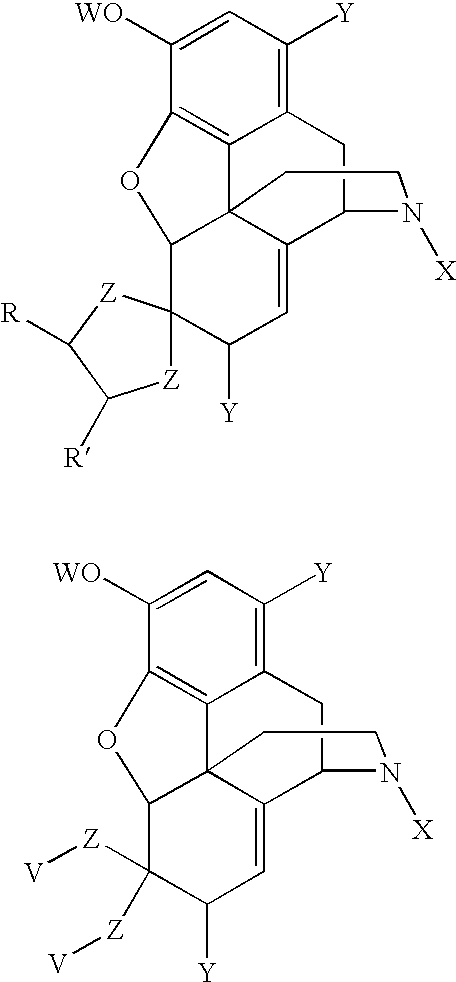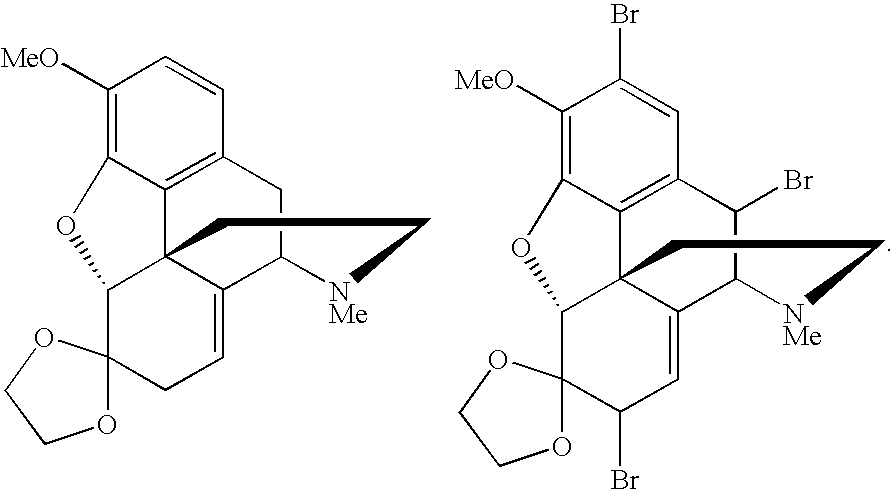Conversion of thebaine to morphine derivatives
a technology of thebaine and morphine, which is applied in the field of morphine derivative synthesis, can solve the problems of limited use of thebaine as a precursor alkaloid and undesirable intermediate production
- Summary
- Abstract
- Description
- Claims
- Application Information
AI Technical Summary
Benefits of technology
Problems solved by technology
Method used
Image
Examples
example 1
Neopinone Ethylene Glycol Ketal (10)
[0050]Thebaine (500 mg, 1.6 mmol, 1.0 eq) was dissolved in CHCl3 (0.9 ml) and ethylene glycol (1.0 g, 16.1 mmol, 10.0 eq) added. To this biphasic solution under vigorous stirring was added TsOH H2O (1.0 g, 5.3 mmol, 3.3 eq). The reaction was heated to reflux for 45 minutes, cooled to 0° C. and the pH adjusted to >11 using saturated aqueous K2CO3 or ammonium hydroxide. Extraction of the reaction solution with CHCl3 (5 ml×3), drying over Na2SO4 and filtration provided a dark yellow residue. Purification by silica gel chromatography (CHCl3:MeOH:NH4OH 98:2:1) provides the title product as a pale yellow oil in 38% yield.
[0051]FTIR (vmax cm−1) film: 3407, 3031, 2924, 2903, 2833, 2791, 1634, 1603, 1504, 1448, 1325, 1277, 1258, 1165, 1050, 1035, 825; 1H NMR (CDCl3, 600 MHz): 6.74 (d, J=8.2 Hz, 1H), 6.64 (d, J=8.2 Hz, 1H), 5.56 (d, J=5.6 Hz, 1H), 4.70 (s, 1H), 4.28 (q, J=6.2 Hz, 1H), 3.93 (q, J=6.8 Hz, 1H), 3.86-3.90 (m, 4H), 3.81 (q, J=6.2 Hz, 1H), 3.64 (...
example 2
Dihydroneopinone Ethylene Glycol Ketal (13)
[0052]A solution of 10 (100 mg, 0.3 mmol) in CHCl3 (1 ml) was treated with Pt / C (10%) under 1 atmosphere of H2 for 16 hours. Filtration through a plug of silica with CHCl3:MeOH:NH4OH 92:8:1 gave the title compound in quantitative yield.
[0053]FTIR (vmax cm−1) film: 2941, 2926, 2889, 1636, 1611, 1502, 1441, 1325, 1275, 1258, 1190, 1155, 1060, 922; 1H NMR (CDCl3, 600 MHz): 6.67 (d, J=8.2 Hz, 1H), 6.55 (d, J=8.2 Hz, 1H), 4.42 (s, 1H), 4.12 (q, J=6.5 Hz, 1H), 3.97 (q, J=5.0 Hz, 1H), 3.78-3.85 (m, 5H), 3.72 (q, J=6.3 Hz, 1H), 3.01-3.05 (m, 1H), 2.93 (d, J=18.3 Hz, 1H), 2.44 (dd, J=12.1, 4.3 Hz, 1H), 2.33 (s, 3H), 2.27 (dd, J=18.2, 5.4 Hz, 1H), 2.09-2.17 (m, 2H), 1.79 (dt, J=12.3, 4.9 Hz, 1H), 1.56-1.66 (m, 2H), 1.41-1.50 (m, 2H), 1.08 (td, J=12.7, 2.2 Hz, 1H); 13C NMR (CDCl3, 125.5 MHz): 146.6, 142.1, 129.2, 126.5, 118.6, 113.4, 108.6, 94.4, 66.4, 64.9, 59.5, 56.5, 47.1, 43.6, 42.9, 42.6, 36.5, 33.4, 22.3, 20.1; MS (EI) m / z (%): 344 (23.3), 343 (...
example 3
Hydrocodone (4) One pot Procedure from 10
[0054]A solution of 10 (45 mg, 0.13 mmol, 1.0 eq) in MeOH (90 μl) was treated with Pt / C (10%) under 1 atmosphere of H2 for 12 hours. 25% v / v H2SO4 / MeOH (0.5 ml) was added to the reaction solution, which was stirred for three hours. The pH of the solution was adjusted to >11 with saturated aqueous K2CO3 and extracted with CHCl3 (5 ml×3). The combined organic extracts were dried over Na2SO4, filtered, concentrated and the crude material purified by column chromatography (CHCl3:MeOH:NH4OH—98:2:1) to yield hydrocodone in 75% yield.
[0055]All analytical data generated for hydrocodone synthesized in this manner is identical with that of an authentic sample of hydrocodone.
PUM
| Property | Measurement | Unit |
|---|---|---|
| structure | aaaaa | aaaaa |
| structures | aaaaa | aaaaa |
| electrophilic | aaaaa | aaaaa |
Abstract
Description
Claims
Application Information
 Login to View More
Login to View More - R&D
- Intellectual Property
- Life Sciences
- Materials
- Tech Scout
- Unparalleled Data Quality
- Higher Quality Content
- 60% Fewer Hallucinations
Browse by: Latest US Patents, China's latest patents, Technical Efficacy Thesaurus, Application Domain, Technology Topic, Popular Technical Reports.
© 2025 PatSnap. All rights reserved.Legal|Privacy policy|Modern Slavery Act Transparency Statement|Sitemap|About US| Contact US: help@patsnap.com



